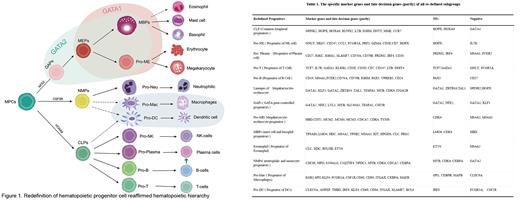The definition of hematopoietic progenitor cells (HPCs) has not been standardized. Surface markers are insufficient to capture the entire differentiation stages of progenitor cells and reflect the dynamic differentiation mechanisms underlying hematopoiesis. Deciphering the hematopoiesis mechanism that underlies progenitor cells definition and fate decision are critical to understanding fundamental questions of hematopoietic lineage commitment.
Here, we redefined the entire spectrum of adult hematopoietic progenitors, and recovered the critical transcript factors (TFs) in lineages fate decision, and reaffirmed the lineage commitment model of HPCs by a comprehensive transcriptome. The progenitor lineages were accurately redefined with unique makers and transcription factors by unsupervised dimensionality reduction and clustering, which subverted the conventional definition of HPCs(Table 1). The expression characteristics of TFs, such as GATA1, KLF1, PRDM1, and MAFB, presented enormous capacity to define the entire spectrum of HPCs.
The transcriptional atlas showed that original hematopoietic progenitors were simultaneously primed into lymphoid, neutrophils, and megakaryocytic-erythroid progenitor cell types in the initial differentiation stage and thereafter matured into different hematopoietic lineages (Figure 1). The common intermediate progenitor stage was not observed among myeloid lineages, indicating the absence of a common myeloid progenitor during the lineage commitment. Our transcriptional atlas revealed the major fate decision factors in each branch among hematopoietic hierarchy formation (Table 1). Several fate decision factors were identified, including GATA2, TESPA1, and MYB of myeloid progenitors and HOXA9, HOPX, and TSC22D1 of lymphoid progenitors. Through the sequential activation/deactivation of TFs, synergism with key receptor genes, and signal activation, the original progenitor cells were primed and differentiated into various progenitors. The expression and activation characteristics of fate decision TFs faithfully reflect the mechanisms underlying hematopoietic lineage commitment.
A hematopoietic hierarchy roadmap was reaffirmed. Our reaffirmed hematopoietic hierarchy validated that the megakaryocytic-erythroid lineage process is continuous, while the lymphoid lineage process is more likely a discrete stepwise progression with distinct lineage-committed populations during hematopoiesis, opening a new perspective on hematopoiesis (Figure 1). Our study revealed that the original progenitors of basophils, eosinophils, and neutrophils differed. Plasma progenitor cells were first identified and defined, and the rearrangements of IGHV, IGKV, and IGLV genes were already existed and occurred during the progenitor state of plasma cells.
In summary, our transcriptional atlas of HPCs provides an accurate definition, hierarchy, and biological insights into hematopoiesis and lineage commitment. Our study opens up numerous possibilities for precise and controlled progenitor cell differentiation, facilitating research development in regenerative medicine and disease treatment.
Disclosures
No relevant conflicts of interest to declare.


This feature is available to Subscribers Only
Sign In or Create an Account Close Modal